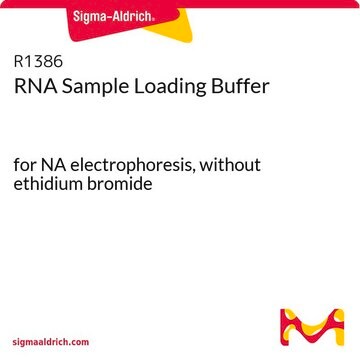R4268
RNA Sample Loading Buffer
for NA electrophoresis, with ethidium bromide (50 μg/mL)
About This Item
Recommended Products
grade
for molecular biology
Quality Level
form
liquid
concentration
1.25 ×
technique(s)
electrophoresis: suitable
foreign activity
RNase, none detected
storage temp.
−20°C
−20°C
Looking for similar products? Visit Product Comparison Guide
Related Categories
General description
Application
RNA Sample Loading Buffer has been used as a sample loading buffer in northern blot.
Components
Quantity
related product
Signal Word
Danger
Hazard Statements
Precautionary Statements
Hazard Classifications
Acute Tox. 4 Inhalation - Carc. 1B - Muta. 2 - Repr. 1B - Skin Sens. 1 - STOT RE 2 Oral
Target Organs
Blood
Storage Class Code
6.1C - Combustible, acute toxic Cat.3 / toxic compounds or compounds which causing chronic effects
WGK
WGK 3
Flash Point(F)
Not applicable
Flash Point(C)
Not applicable
Regulatory Listings
Regulatory Listings are mainly provided for chemical products. Only limited information can be provided here for non-chemical products. No entry means none of the components are listed. It is the user’s obligation to ensure the safe and legal use of the product.
EU REACH SVHC Candidate List
EU REACH Annex XVII (Restriction List)
Certificates of Analysis (COA)
Search for Certificates of Analysis (COA) by entering the products Lot/Batch Number. Lot and Batch Numbers can be found on a product’s label following the words ‘Lot’ or ‘Batch’.
Already Own This Product?
Find documentation for the products that you have recently purchased in the Document Library.
Customers Also Viewed
Our team of scientists has experience in all areas of research including Life Science, Material Science, Chemical Synthesis, Chromatography, Analytical and many others.
Contact Technical Service













